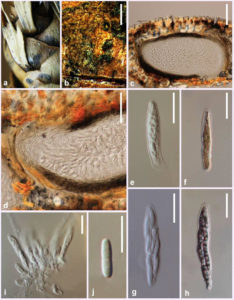Diaporthe pseudotsugae Dissanayake, Camporesi & K.D. Hyde, sp. nov., Index fungorum number: IF553190
Etymology: The specific epithet pseudotsugae is based on the host genus (Pseudotsuga).
Saprobic on dead land cones of Pseudotsuga menziesii (Mirb.). Sexual morph: Ascomata up to 465 μm in diameter, 255 μm high, black, globose to oval, clustered in groups, deeply immersed in host tissue protruding through substrata. Peridium 28–42 μm thick, inner layer composed of light brown textura angularis, outer layer composed of dark brown textura angularis. Asci 60–85 × 21–37 μm (x̅ = 75 × 29 μm), unitunicate, 8-spored, sessile, elongate to clavate. Ascospores 19–21 × 6–8 μm (x̅ = 20 × 7 μm), hyaline, two-celled, often 4-guttulate, with larger guttules at centre and smaller ones at the ends, elongated to elliptical. Asexual morph: Not observed.
Material examined: ITALY, Forlì-Cesena Province, Premilcuore, on dead land cones of Pseudotsuga menziesii (Pinaceae), 10 April 2015, Erio Camporesi; (MFLU 15-1274, holotype).
Notes: We could not obtain a culture from single ascospore. Therefore, DNA was extracted directly from the ascomata. Diaporthe pseudotsugae occurs in a clade separate from D. salicicola, D. cynaroidis, D. cassines and D. nothofagi. Although D. pseudotsugae is a sexual morph, none of the above mentioned species possess any sexual morph. Phylogenetically, D. cassines is the closest species to D. pseudotsugae, differing by 64 nucleotides in the
concatenated alignment, in which 34 were distinct in the ITS region, 30 in the TEF region. Though the sequences of BT region and CAL region are available for D. pseudotsugae, the sequences of those regions are unavailable for D. cassines.
Fig. Diaporthe pseudotsugae (MFLU 15-3228, holotype). a, b Ascomata on host surface. c Cross section of ascoma. d Peridium. e Immature ascus. f Immature ascus immersed in Indian ink. g Mature ascus. h Mature ascus mounted in methylene blue. i Cluster of immature asci. j ascospore. Scale bars: b = 1 mm, c, d = 100 μm, e–i = 30 μm, j = 20 μm.

